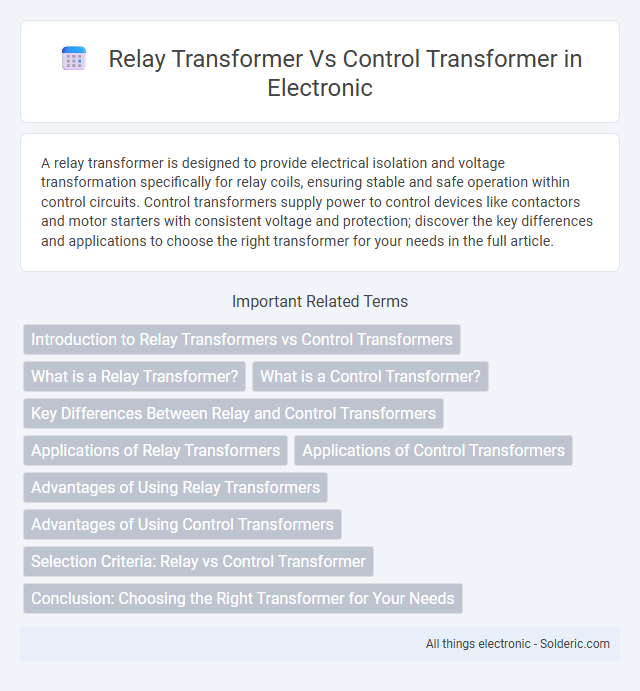A relay transformer is designed to provide electrical isolation and voltage transformation specifically for relay coils, ensuring stable and safe operation within control circuits. Control transformers supply power to control devices like contactors and motor starters with consistent voltage and protection; discover the key differences and applications to choose the right transformer for your needs in the full article.
Comparison Table
| Feature | Relay Transformer | Control Transformer |
|---|---|---|
| Primary Function | Isolates and steps down voltage for relay circuits | Provides stable voltage supply for control devices |
| Voltage Rating | Typically low to medium voltage, based on relay requirements | Low voltage, optimized for control circuit stability |
| Power Rating | Low power, suitable for relay coils | Moderate power for control panels and devices |
| Load Type | Intermittent, mostly relay coil loads | Continuous, supporting control circuits |
| Design | Compact, designed for relay protection requirements | Robust, built for steady voltage control |
| Application | Relay protection systems in electrical circuits | Control panels, motor starters, and automation systems |
| Typical Efficiency | High at low loads | Consistent efficiency under continuous load |
| Cost | Generally lower due to simpler design | Higher due to reliability and stable output |
Introduction to Relay Transformers vs Control Transformers
Relay transformers and control transformers serve distinct roles in electrical systems, with relay transformers primarily designed to isolate and step down voltages to safely operate relays. Control transformers provide stable voltage output to power control circuits, instruments, and auxiliary devices, ensuring precise operation and protection. Understanding your application's voltage and current requirements helps determine whether a relay or control transformer best suits your control system needs.
What is a Relay Transformer?
A relay transformer is a specialized device designed to supply low-voltage power to protective relay circuits, ensuring accurate operation of electrical protection systems in transformers and switchgear. It provides galvanic isolation between the control circuit and the power system, enhancing safety and signal integrity. Unlike control transformers, relay transformers prioritize precision voltage regulation and minimal interference to support sensitive relay functions.
What is a Control Transformer?
A control transformer is a specialized electrical device designed to provide a stable and reduced voltage supply specifically for control circuits in industrial and commercial applications. It ensures reliable operation of control components such as relays, timers, and contactors by delivering consistent voltage regardless of fluctuations in the main power supply. You rely on control transformers to protect sensitive control equipment and maintain efficient performance in complex electrical systems.
Key Differences Between Relay and Control Transformers
Relay transformers primarily function to isolate or switch electrical circuits by controlling current flow, while control transformers are designed to provide a stable voltage for control circuits in machinery and automation systems. Relay transformers often handle higher power switching applications, whereas control transformers deliver precise voltage regulation to protect sensitive equipment. Your choice hinges on whether you need circuit isolation and switching (relay) or consistent, low-voltage power supply (control).
Applications of Relay Transformers
Relay transformers are primarily used in protection circuits to isolate and control electrical relays by stepping down voltage to a safer, manageable level, ensuring reliable relay operation in industrial and power distribution systems. They provide voltage regulation and signal isolation, making them ideal for applications such as motor starters, circuit breakers, and automation control panels. Your system's safety and efficiency can be enhanced by selecting the appropriate relay transformer for precise voltage control in relay-based control circuits.
Applications of Control Transformers
Control transformers are primarily used in low-voltage control circuits, providing stable and isolated power to control devices such as relays, contactors, and timers. They ensure consistent voltage supply in industrial automation, motor control panels, and HVAC systems to protect sensitive control components from voltage fluctuations. These transformers are essential in manufacturing plants and commercial buildings for reliable operation of control equipment.
Advantages of Using Relay Transformers
Relay transformers offer enhanced electrical isolation and voltage regulation, ensuring accurate current control in relay circuits. They improve system reliability by minimizing electromagnetic interference and reducing the risk of relay coil damage due to voltage spikes. Their compact size and efficiency make them ideal for precise switching applications in industrial automation and control systems.
Advantages of Using Control Transformers
Control transformers provide stable voltage output essential for precise operation of control circuits, enhancing reliability in electrical systems. Their design minimizes heat generation and energy loss, contributing to improved efficiency and extended equipment lifespan. You benefit from safer and more consistent control power, reducing downtime and maintenance costs in industrial applications.
Selection Criteria: Relay vs Control Transformer
Selection criteria for relay transformers prioritize compatibility with relay coil voltage ratings and response time, ensuring reliable actuation in control circuits. Control transformers are selected based on voltage regulation, load capacity, and isolation requirements to provide stable power to control devices. Evaluating factors such as voltage levels, load characteristics, insulation class, and application-specific demands guides the optimal choice between relay and control transformers.
Conclusion: Choosing the Right Transformer for Your Needs
Relay transformers offer high isolation and are ideal for signal switching and protection circuits, whereas control transformers provide stable voltage regulation for equipment operation. Your specific application requirements, such as load capacity and voltage stability, determine the optimal choice between these transformers. Selecting the right transformer ensures efficient performance and longevity in your electrical system.
relay transformer vs control transformer Infographic

 solderic.com
solderic.com